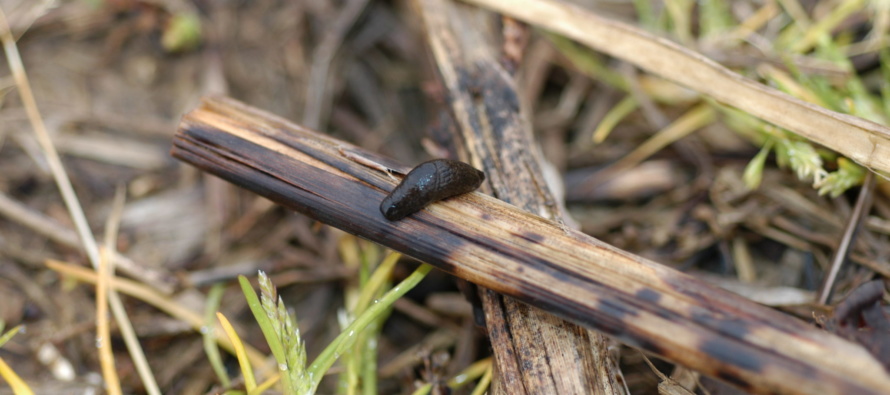Cool, Wet Weather, and Residue Brings Slugs

Related Articles
- 2010 Soybean And Corn Variety Trial Data 3
- Fertilizing Cotton with Poultry Litter 5
- Mississippi Cotton Insect Situation of 2010: A Look Back 3
Latest Tweets
I have recently received a few call about slugs in corn. I suspect this will increase in more crops as planting continues and they begin to emerge. Slug problems usually start on corn first, then move to soybeans, then cotton in our area. This is only because we typically plant in this order. Slugs have been a sporadic problem in MS row crops over the years with increased occurrence since 2004. This has been exclusively a no-till or reduced till problem, particularly no-till behind a grass crop like corn or grain sorghum. Cool wet years are particularly favorable for slug problems to develop.
First, it is important to realize that in Mississippi we commonly encounter snails and slugs in the same the field. The easiest way to tell which one you are dealing with is, just remember: snails have shells, slugs do not have shells. Snails are often present in the daylight, slugs are often hid under debris in the daylight. Snails DO NOT EAT YOUR CROP (or at least the species we have), slugs will eat your crop. I get numerous calls each year about snails in all crops. They are very visible on the plants and most people just assume they are a problem when they are not. I have seen numbers of snails so high on seedling plants that the weight from them has bent the plant to the ground but they cause no feeding injury. In most situations snails and slugs occur together. Slugs come out at night and eat the plants and then move under the debris to hide in the daylight. Because the snails are on the plant during the day, often they get blamed for the damage the slugs caused.
It is fairly ease to diagnose slug problems. They are foliage feeders and above ground symptomology usually resembles defoliation you would see from other pest such as grasshoppers, bean leaf beetles, or even some caterpillar pests. If you are in a no-till or reduced tillage situation and observe this feeding on seedling plants, simply rake the residue back and dig around some and they are usually easy to find.
In 2005, Dr. Jeff Gore and I conducted several studies looking at control options with limited success. Insecticides simply do not work. Each year that we have a slug problem, I have numerous folks tell me about how they have had luck with insecticides on slugs. I am here to tell you, you can waste time and money chasing slugs with insecticides, we have tested them all in topical and feeding assays with no luck. The only viable option we found was products that contain metaldehyde as the active ingredient which is made for slug and snail control. Deadline MP™s by Amvac worked extremely well but is costly. Deadline MP™s is a pellet that must be broadcast at rates of 10-40 lbs per acre. The 10 lb rate is approximately $18.00-20.00/acre. The pellets attract the slugs where they feed and die. In a replicated test we conducted in 2005, we had a 96% percent reduction in slug numbers at the 10 lb rate compared to the untreated check. Option 2: If you have a persistent problem, tillage may be required. Also, dropping your residue removers down where they scratch the soil surface more than usual has been reported to provide enough of a clean band to get the plants up and going to get some size on them; however this does not always work under heavy pressure.
This is a serious problem where they occur and often leads to replants if they eat the growing point from cotton or soybeans. Corn generally comes back even if it is grazed to the ground because the growing point is not harmed. Keep in mind, if you have to replant, the slugs will still be there and you will be replanting back into the problem. In 2004, we had some fields that were replanted from slug damage and the replants were replanted from slug damage.
As long as the slugs are only feeding on the leaves and not the growing point, the plants will usually grow out of the problem with no yield loss, but it can delay the crop. The most severe damage caused by slugs is when they “run the drill”. This is when the press wheels do not close the seed furrow properly and slugs feed on the stems below the ground which causes them to break off and looks like cutworm damage. This can lead to extreme stand loss. The best solution to the problem is good dry growing conditions so the plants can simply outgrow the problem.





Good information. I was not clear about the damage of crops by slugs and snails.